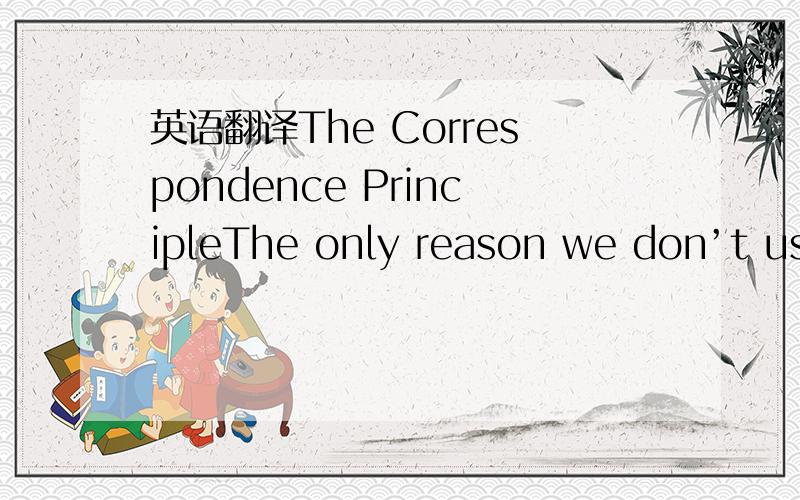英语翻译The Correspondence PrincipleThe only reason we don’t usually notice diffraction of light in everyday life is that we don’t normally deal with objects that are comparable in size to a wavelength of visible light,which is about a millio
来源:学生作业帮助网 编辑:作业帮 时间:2024/04/27 13:11:57

英语翻译The Correspondence PrincipleThe only reason we don’t usually notice diffraction of light in everyday life is that we don’t normally deal with objects that are comparable in size to a wavelength of visible light,which is about a millio
英语翻译
The Correspondence Principle
The only reason we don’t usually notice diffraction of light in everyday life is that we don’t normally deal with objects that are comparable in size to a wavelength of visible light,which is about a millionth of a meter.Does this mean that wave optics contradicts ray optics,or that wave optics sometimes gives wrong results?No.If you hold three fingers out in the sunlight and cast a shadow with them,either wave optics or ray optics can be used to predict the straightforward result:a shadow pattern with two bright lines where the light has gone through the gaps between your fingers.
Wave optics is a more general theory than ray optics,so in any case where ray optics is valid,the two theories will agree.This is an example of a general idea enunciated by the physicist Niels Bohr,called the correspondence principle:when flaws in a physical theory lead to the creation of a new and more general theory,the new theory must still agree with the old theory within its more restricted area of applicability.After all,a theory is only created as a way of describing experimental observations.If the original theory had not worked in any cases at all,it would never have become accepted.
In the case of optics,the correspondence principle tells us that when λ/d is small,both the ray and the wave model of light must give approximately the same result.Suppose you spread your fingers and cast a shadow with them using a coherent light source.The quantity λ/d is about 10 –4,so
the two models will agree very closely.(To be specific,the shadows of your fingers will be outlined by a series of light and dark fringes,but the angle subtended by a fringe will be on the order of 10–4 radians,so they will be invisible and washed out by the natural fuzziness of the edges of sunshadows,caused by the finite size of the sun.)
Self-Check
What kind of wavelength would an electromagnetic wave have to have in order to diffract dramatically around your body?Does this contradict the correspondence principle?
It would have to have a wavelength on the order of centimeters or meters,the same distance scale as that of your body.These would be microwaves or radio waves.(This effect can easily be noticed when a person affects a TV’s
reception by standing near the antenna.) None of this contradicts the correspondence principle,which only states
that the wave model must agree with the ray model when the ray model is applicable.The ray model is not applicable here because λ/d is on the order of λ.
英语翻译The Correspondence PrincipleThe only reason we don’t usually notice diffraction of light in everyday life is that we don’t normally deal with objects that are comparable in size to a wavelength of visible light,which is about a millio
对应原理
日常生活中我们一般注意不到光的衍射,唯一的原因是我们通常接触不到与可见光波长大小(即百万分之一米左右)相当的物体.那么,是不是光波学与光线学矛盾呢?还是光波学有时会出错?都不是的.如果你对着光并起三根手指,遮出一片阴影,不管用光波学还是用光线学都可以简单明了地预测阴影的形状:阴影中夹着两道明亮的光线,那是由指缝漏下的阳光.
光波学与光线学相比更具有普遍性,因此只要是在光线学有效的情况下,两种理论都是一致的.物理学者Niels Bohr阐述普遍观念时提出一个例子,称作对应理论:当一个物理理论的瑕疵引出一个新的,更普遍的理论,新的理论在其更有限的适用范围内必须与旧理论一致.毕竟,理论只是对于实验观察的描述,如果旧理论不是普遍适用,则它不可能被普遍接受.
就光学而言,对应理论告诉我们,如果λ/d值很小,那么光的波和射线模型结果就相近似.假设你张开手指,制造一个光的相干辐射源,形成一片阴影.λ/d的值大约是10 –4,这样两种模型结果就非常相近.(具体来说,手指会形成这样的阴影:周围是一系列光边和暗边,但由于每条边对应的角都符合10–4弧度,我们看不见这些边,因为太阳大小有限,自然界对于阳光造成的阴影的边界会产生模糊作用)
自我检查
要让电磁波在你身体周围产生明显的衍射,波长应该是多少呢?这与对应原理矛盾吗?
它的波长应该以厘米或米计,即与你身体的线性比例相当.它应该是微波或者无线电波.(生活中常有此类现象:人站在天线附近可以感觉到电视在接收信号.)这与对应原理一点也不矛盾,因为对应原理是说只有当光线学有效时,光波学应与光线学一致,而此处光线学不适用,应为λ/d值近似于λ .
书信原则我们通常不注意的唯一的原因光的衍射在日常生活中是我们通常不应付是可比较的在大小与可见光波长, 是百万分之一分之一米的对象。这个手段, 波浪光学抗辩光芒光学, 或波浪光学有时给错误结果? 不。如果您握三个手指在阳光下和投下阴影与他们, 或波浪光学或光芒光学可能使用预言直接的结果: 一个阴影样式以光审阅空白在您的手指之间的二条明亮的线。波浪光学比光芒光学, 如此在任何情况下是一种更加一般的理论...
全部展开
书信原则我们通常不注意的唯一的原因光的衍射在日常生活中是我们通常不应付是可比较的在大小与可见光波长, 是百万分之一分之一米的对象。这个手段, 波浪光学抗辩光芒光学, 或波浪光学有时给错误结果? 不。如果您握三个手指在阳光下和投下阴影与他们, 或波浪光学或光芒光学可能使用预言直接的结果: 一个阴影样式以光审阅空白在您的手指之间的二条明亮的线。波浪光学比光芒光学, 如此在任何情况下是一种更加一般的理论光芒光学是合法的, 二种理论将同意。这是一个一般想法的例子由物理学家Niels Bohr 吐字, 称书信原则: 当缺点在一种物理理论导致一种新和更加一般的理论的创作, 新理论必须仍然与老理论一致在适用性之内它的禁区。终究, 理论只被创造作为描述实验性观察方式。如果原始的理论未运作在任何案件根本, 它从未会成为接受。在光学情况下, 书信原则告诉我们当?/d 小, 光芒并且光波浪模型必须近似地给同样结果。假设您涂您的手指和投下阴影与他们使用一个连贯光源。数量?/d 是大约10 -4, 因此二个模型非常严密将同意。(是具体的, 您的手指的阴影将由一系列的光和黑暗的边缘概述, 但角度由边缘subtended 将是大约10-4 个弧度, 因此他们将是无形和由sunshadows 边缘的自然模糊洗涤, 由太阳的有限大小造成。) 自检什么样的波长电磁波会必须有为了显著衍射在您的身体附近? 这抗辩书信原则吗? 它会必须有波长大约厘米或米, 距离标度和那您的身体一样。这些会是微波或无线电波。(这个作用可能容易地被注意当人影响电视的招待会由站立在天线附近。) 无这抗辩书信原则, 只阐明, 波浪模型必须与光芒模型一致当光芒模型是可适用的。光芒模型不是可适用的这里因为?/d 是大约? 。
收起
书信原则的唯一理由我们不该光衍射公告通常在日常生活中,我们不该 处理对象通常是一个规模可比可见光波长, 距今大约有百万分之一公. 这是否意味着波动光学与光射线或波光学有时候给人错误的结果? 第三,如果你的手指在阳光下进行,并与他们投下阴影, 要么波光学或光线光学可直接用来预测结果: 影子模式两种明亮的光线下走过的差距你的手指. 波动光学是一个更比一般射线光学理论,在任何情况下,如光光学有效期、 两...
全部展开
书信原则的唯一理由我们不该光衍射公告通常在日常生活中,我们不该 处理对象通常是一个规模可比可见光波长, 距今大约有百万分之一公. 这是否意味着波动光学与光射线或波光学有时候给人错误的结果? 第三,如果你的手指在阳光下进行,并与他们投下阴影, 要么波光学或光线光学可直接用来预测结果: 影子模式两种明亮的光线下走过的差距你的手指. 波动光学是一个更比一般射线光学理论,在任何情况下,如光光学有效期、 两个理论都同意. 这是一个普通的物理学家玻尔阐述理念,称为对应原理: 在理论物理缺陷导致建立一个新的、更一般理论, 新理论必须同旧理论还是同意其适用性更加禁区. 毕竟只是一个理论创造的一种方法描述实验观察. 如果原论在任何情况下未能奏效的话,我们就永远成为接纳. 在涉及光学原理告诉我们,当书信/丁是丁、 无论射线和波模式轻大约要收到同样的效果. 假如你的手指和阴影蔓延你同他们用相干光源. 数量/数约为10的C4,那么这两个型号都同意非常密切. (将特定的阴霾将你的手指勾划出一系列的灯光黑暗角落, 但附带一个角度花被将于秩序10c4弧度, 因此,他们将无形的自然淘汰边缘模糊sunshadows, 因规模有限阳光). 自检何种波长的电磁波都将产生 为了衍射戏剧性左右你的身体? 这是否对应原则? 它必须有一个波长的顺序公分还是米 同样的距离,你身上规模. 这将微波或无线电波. (大意容易看见一个人的身高影响了电视接收天线附近). 无 这与函授原则 它只是说必须同意射线波示范模型当光线模型适用. 射线模式并不适用,因为这里/丁于秩序.
收起